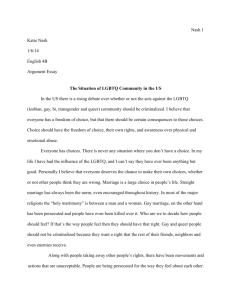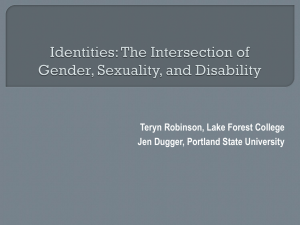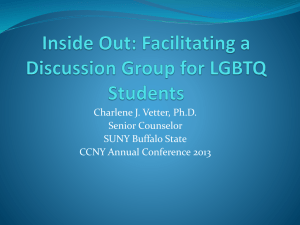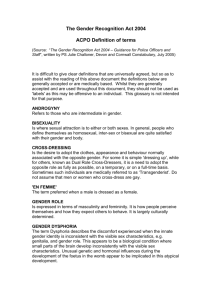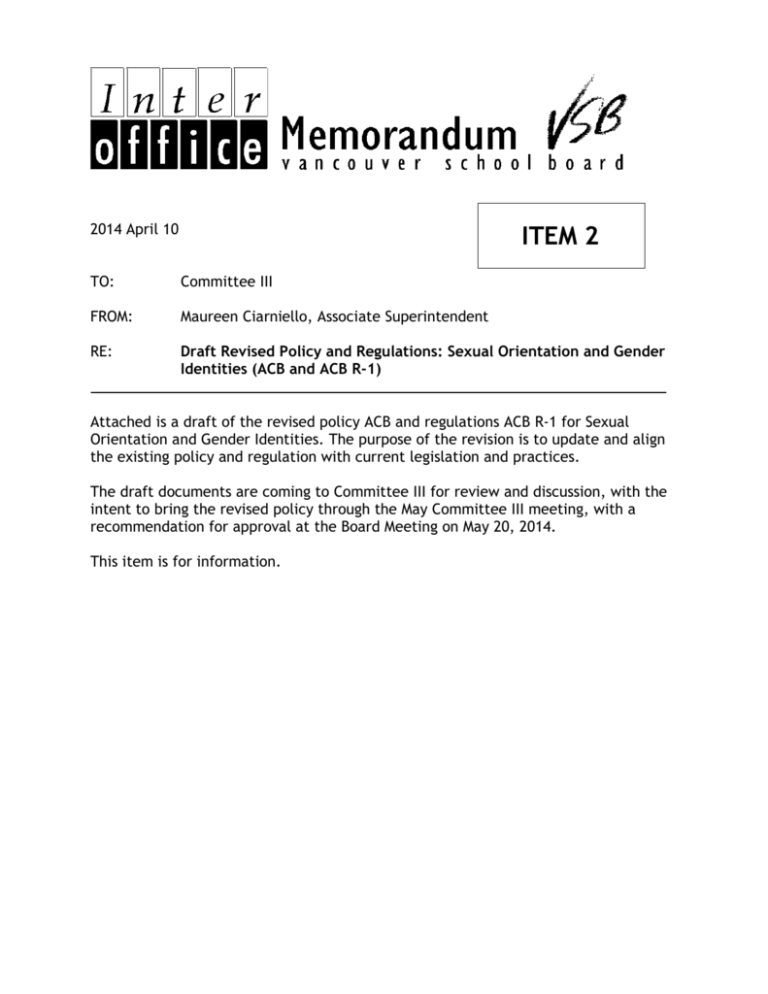
ITEM 2
2014 April 10
TO:
Committee III
FROM:
Maureen Ciarniello, Associate Superintendent
RE:
Draft Revised Policy and Regulations: Sexual Orientation and Gender
Identities (ACB and ACB R-1)
Attached is a draft of the revised policy ACB and regulations ACB R-1 for Sexual
Orientation and Gender Identities. The purpose of the revision is to update and align
the existing policy and regulation with current legislation and practices.
The draft documents are coming to Committee III for review and discussion, with the
intent to bring the revised policy through the May Committee III meeting, with a
recommendation for approval at the Board Meeting on May 20, 2014.
This item is for information.
POLICY STATEMENT:
ACB: Sexual Orientation and Gender Identities
Classification:
A: Foundations and Basic Commitments
Code: ACB
The Board of Education (the “Board”) is committed to establishing and maintaining a safe,
inclusive, equitable, and welcoming learning and working environment for all members of the
school community, including all students and employees who identify as (or are perceived as)
lesbian, gay, bisexual, trans*, Two Spirit, intersex, queer and those who are questioning their
sexual orientation and/or gender identity (LGBTQ+).
The Board believes that all LGBTQ+ students, staff and families have the right to have:
•
their confidentiality protected and respected;
•
self-identification and determination; and
•
their unique identities, families, cultures, and communities included, represented, valued,
and respected within all aspects of the school environment.
The Board will promote pro-active strategies and guidelines so that all members of this diverse
community are welcomed, respected, accepted and supported in every school and worksite.
The Board is committed to implementing measures that will:
• define appropriate expectations, language, behaviours and actions in order to prevent
discrimination and harassment;
• ensure that homophobic and transphobic complaints are taken seriously and dealt with
expeditiously and effectively through consistently applied policy and procedures;
• raise awareness and improve understanding of the lives of people who identify as
LGBTQ+; and
• strive to eliminate the systemic inequities and barriers for members of the school
community who identify as LGBTQ+ (or are perceived as such) and demonstrate
accountability in leadership so that everyone is treated with fairness and respect.
1
REGULATIONS
Regulation ACB – R – 1-- Sexual Orientation and Gender Identities
A.
Anti-Harassment
The Board will strive to prevent and to provide effective procedures to respond to any language
or behaviour that degrades, denigrates, labels, or stereotypes students on the basis of their
sexual and/or gender identities and/or gender expression, or that incites hatred, prejudice,
discrimination or harassment towards those individuals on such bases.
B.
Leadership
The Board will consult with the Pride Advisory Committee to ensure that policy directions,
priorities and implementation of programs and services are consistent with this Sexual
Orientation and Gender Identities policy.
There will be ongoing, constructive and open dialogue with LGBTQ+ communities to increase
co-operation and collaboration among home, school and the community.
Administrators, teachers, counsellors, and other staff and student leaders should consult with
LGBTQ+ students and their designated support groups and take concrete actions to make
schools more welcoming, inclusive and safer places.
Staff will not refer students to programs or services that attempt to change a student’s sexual
orientation or gender identity.
C.
Professional Development and Training
The Board will strive to ensure that professional development and training is provided for staff
to develop the awareness, knowledge, skills and attitudes necessary to:
• deliver an LGBTQ+ inclusive curriculum (including anti-homophobia and anti-transphobia
education);
• identify and address homophobic and transphobic discriminatory attitudes and behaviours;
and
• support and advocate for the needs of students who identify as LGBTQ+ (or are perceived as
such).
D.
Counselling and Student Support
The Board will ensure that:
• counsellors are trained to respond competently to the needs of LGBTQ+ students as well as
to the needs of students with LGBTQ+ family members;
• elementary and secondary schools appoint at least one staff person to be a Safe Contact
who is able to act as a resource person for LGBTQ+ students, staff and families. (Note: School
administrators will act as the Safe Contact if no one voluntarily steps forward.) School
administrators will inform students and other staff about the location and availability of this
contact person; and
• all secondary schools are supported in establishing and maintaining Gay or Queer/Straight
Alliance clubs.
E.
Curriculum Learning Resources
The Board is committed to:
• ensuring that staff utilizes language and educational resources and approaches that are
inclusive, developmentally appropriate, and respectful of diverse sexual orientations, gender
identities, and gender expressions;
• enabling all LGBTQ+ students and families to see themselves and their lives positively
reflected in the curriculum, through the provision of library and other curricular resources;
• creating or acquiring developmentally appropriate, current and relevant learning resources
for sexual health education that are LGBTQ+ inclusive; and
• providing learning resources in languages and in formats easily accessible to ELL students
and their families, where possible.
F.
Communications
The Board will:
• acknowledge through its communication to students, staff, and the community that some
students live in LGBTQ+ families and need to be positively recognized and included as such;
and
• ensure that school forms and communications reflect the diversity of gender identities of
students, staff and parents/guardians.
G.
Gender Identity and Gender Expression
To support the safety, health, and educational needs of students who identify as, or are
perceived to be, trans*, district staff shall adhere to the following practices wherever possible
and appropriate.
1. Confidentiality and Privacy
a) A student’s trans* status, legal name, or gender assigned at birth may constitute
confidential personal information that will be kept confidential unless its disclosure is
legally required or unless the independent student or the student’s parent(s)/guardian
have given authorization.
b) In situations where school staff or administrators are required by law to use or to report
a trans* student’s legal name or sex, such as for purposes of data collection, school staff
and administrators will adopt practices to avoid the inadvertent disclosure of such
information.
c) Students’ rights to discuss and express their gender identity and/or gender expression
openly and to decide when, with whom, and how much private information to share,
will be recognized and protected.
2. Names and Pronouns
Trans* students will be addressed by the name and pronoun that corresponds to their
gender identity.
3. Official Records and Student Information
a) Whenever possible and permitted by law, requests made by an independent student, or
the parent/guardian, to change the student’s official record to reflect their preferred
name and/or gender identity will be accommodated.
b) Whenever possible, a student’s preferred name and/or gender identity will be included
on class lists, timetables, student files, identification cards, etc.
c) To protect student safety, communications between school and home shall use a
student’s legal name and the pronoun corresponding to the student’s gender assigned
at birth unless the independent student or the parent/guardian has specified otherwise.
4. Dress
Students have the right to dress in a manner consistent with their gender identity or gender
expression. This includes students who may dress in a manner that is not consistent with
societal expectations of masculinity/femininity.
5. Sex-segregated Activities
Schools will reduce or eliminate the practice of segregating students by sex. In situations
where students are segregated by sex, such as for health education classes, trans* students
will have the option to be included in the group that corresponds to their gender identity.
6. Access to Physical Education and Sports
a) Where possible, students will be permitted to participate in any sex-segregated
recreational and competitive athletic activities, in accordance with their gender identity.
Due to issues of disclosure and safety, some students may wish to participate in a sexsegregated activity that is not aligned with their gender identity.
b) Trans* students shall be provided the same opportunities to participate in physical
education as all other students, shall not be asked or required to have physical
education outside of the assigned class time, and shall be permitted to participate in any
sex-segregated activities in accordance with their gender identity if they so choose.
7. Washroom and Change Room Accessibility
a) The use of washrooms and change rooms by trans* students shall be assessed on a caseby-case basis with the goals of maximizing the student’s social integration, ensuring the
student’s safety and comfort, minimizing stigmatization and providing equal opportunity
to participate in physical education classes and sports.
b) Trans* students shall have access to the washroom and change room that corresponds
to their gender identity. Students who desire increased privacy will be provided with a
reasonable alternative washroom and/or changing area. Any alternative arrangement
will be provided in a way that protects the student’s ability to keep their trans* status
confidential.
c) The decision with regard to washroom and change room use shall be made in
consultation with the trans* student.
d) The Board will strive to make available an all-gender/gender neutral washroom at all
school locations and worksites.
8. Student Transfers
Schools will aim to keep trans* students at their original school site, unless it is a student’s
wish to transfer. Should the student wish to transfer, it is not necessary to disclose the
student’s gender identity and/or gender expression as the reason for transfer.
9. Resolving Conflict
Disputes will be resolved in a manner that involves the trans* student and an adult ally
(teacher, service provider, parent/guardian) in the decision-making process to maximize
inclusiveness.
Glossary
Asexual: A person who is not sexually attracted to any gender or sex. Asexual people may still be
romantically attracted to people of a variety of genders and sexualities and have romantic, nonsexual relationships.
Bisexual: A person who is attracted to both women and men.
Gay: A person who is attracted to someone of the same sex and/or gender as themselves. This
word can be applied to all genders of relationships, but has primarily been used in reference to
men.
Gender: A socially constructed concept of identity based on roles, behaviours, activities, and
appearance such as masculine, feminine, androgynous, etc.
Gender expression: The ways a person presents their sense of gender to others (for example,
through clothes, hairstyle, mannerisms, etc.).
Gender identity: A person’s internal sense of being a man, a woman, genderqueer etc. This is not
the same thing as a person’s biological sex, and may not be consistent with how they are
perceived by others.
Gender nonconforming: A term that often refers to children who express gender in ways that
differs from societal expectations of the sex and gender assigned to them at birth. For the
purposes of this policy and accompanying regulations gender nonconforming children are
included under the term trans*.
Homophobia: The fear, ignorance and mistreatment of people who are, or are perceived to be,
lesbian, gay or bisexual. This often leads to bias, discrimination, hatred, harassment and violation
of the human rights of lesbian, gay or bisexual people. Homophobic bullying can also be targeted
against any individual, regardless of perceived sexual orientation.
Intersex: Refers to people whose reproductive or sexual anatomy is not easily defined as male or
female. There are a variety of ways someone can be intersex, ranging from having ambiguous
genitalia to having mixture of XX and XY chromosomes. Intersex individuals have historically been
mistreated in North American society (i.e. being forced to have “corrective” genital surgeries as
infants). The word hermaphrodite was historically used to describe intersex individuals, however,
this term is considered highly offensive.
Lesbian: A woman who is attracted to other women.
LGBTQ+: An acronym that in this case stands for lesbian, gay, bisexual, and queer/questioning.
There are a wide range of other terms often included in this acronym (often referred to by queer
communities as “the alphabet soup”) such as asexual, Two Spirit, intersex, etc., and this acronym
tends to vary depending on the source. The plus sign (+) indicates the inclusion of all sexual and
gender identities within queer communities.
Pronouns: The words one uses to refer to themselves (e.g. he, she, his, hers, they, etc.)
Queer: An umbrella term (often used in place of the LGBTQ+ acronym) used to describe
individuals who identify as being part of sexual and gender diverse communities (i.e. lesbian, gay,
transgender).
Sex: A biological classification based on physical attributes such as sex chromosomes, hormones,
internal reproductive structures, and external genitalia. At birth, it is used to identify individuals
as male or female. For those whose sex is not easily categorized as male or female see Intersex.
Sexual Orientation: Refers to a person’s attraction towards a particular gender or sex. Someone
may identify as lesbian, gay, bisexual, queer, pansexual, etc. It is important to remember that
sexual identity and gender identity are separate.
Trans*: (also Trans, Transgender, Transsexual) An umbrella term that can be used to describe
people whose gender identity and/or gender expression differs from what they were assigned at
birth. Some trans* people may choose to medically transition by taking hormones, having
surgery. Some trans* people may choose to socially transition by changing their name, clothing,
hair, etc.
Transphobia: Fear, ignorance and mistreatment of people who are, or are perceived to be, trans*
or gender nonconforming. This often leads to bias, discrimination, hatred, harassment and
violation of the human rights of transgender or gender nonconforming people. Transphobic
bullying can also be targeted against any individual, regardless of perceived gender expression.
Transition: A term most commonly used to refer to someone transitioning from one gender to
another. Transition often consists of a change in style of dress, selection of a new name, and a
request that people use the correct pronoun when describing them. Transition may, but does not
always, include medical care like hormone therapy, counseling, and/or surgery.
Two Spirit: An Aboriginal term describing the embodiment of both masculine and feminine
spirits. This identity is not limited to gender expression or sexuality, but encompasses them both
while incorporating a spiritual element. It is a standalone identity, not an Aboriginal term for gay
or lesbian.
(These definitions are adapted from Questions & Answers for Parents and Family Members of Gender Variant and
Transgendered Youth (Vancouver School Board, 2011) by Kyle Shaughnessy and other members of the Vancouver
School Board’s Pride Advisory Committee.)
DMT Responsibility: AS-LS
Cross References:
ACA: Multiculturalism and Anti-Racism; FB: Facilities Planning; GBAB: Employment Equity; GBCBA:
Sexual Harassment; IGBA: Programs for Disabled Students; IIA: Instructional Materials; IIAE: Hate
Crimes and Propaganda; JB: Equal Educational Opportunities; KLB: Public Complaints about the
Curriculum/Instructional Materials
Adopted Date:
Monday February 16, 2004

